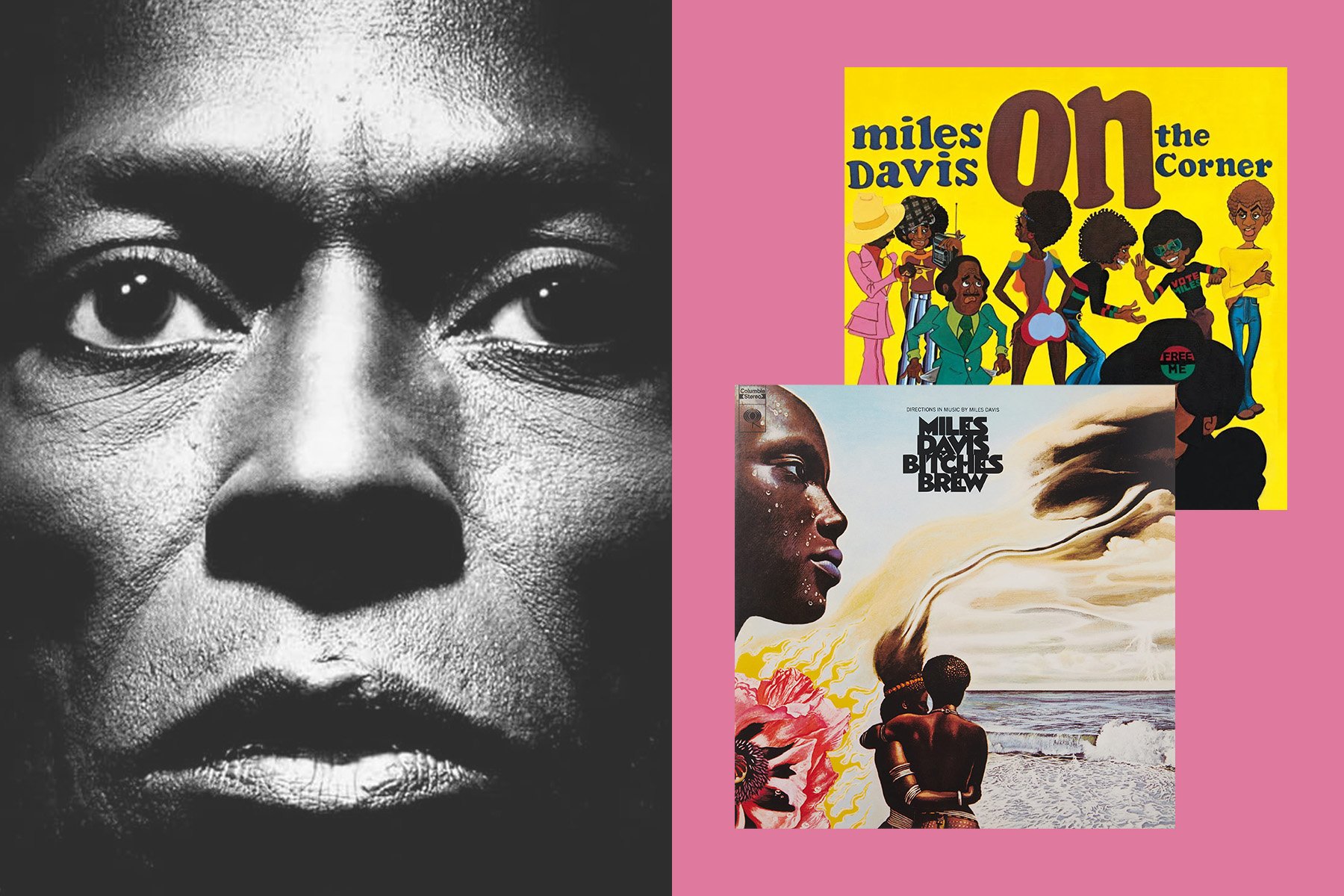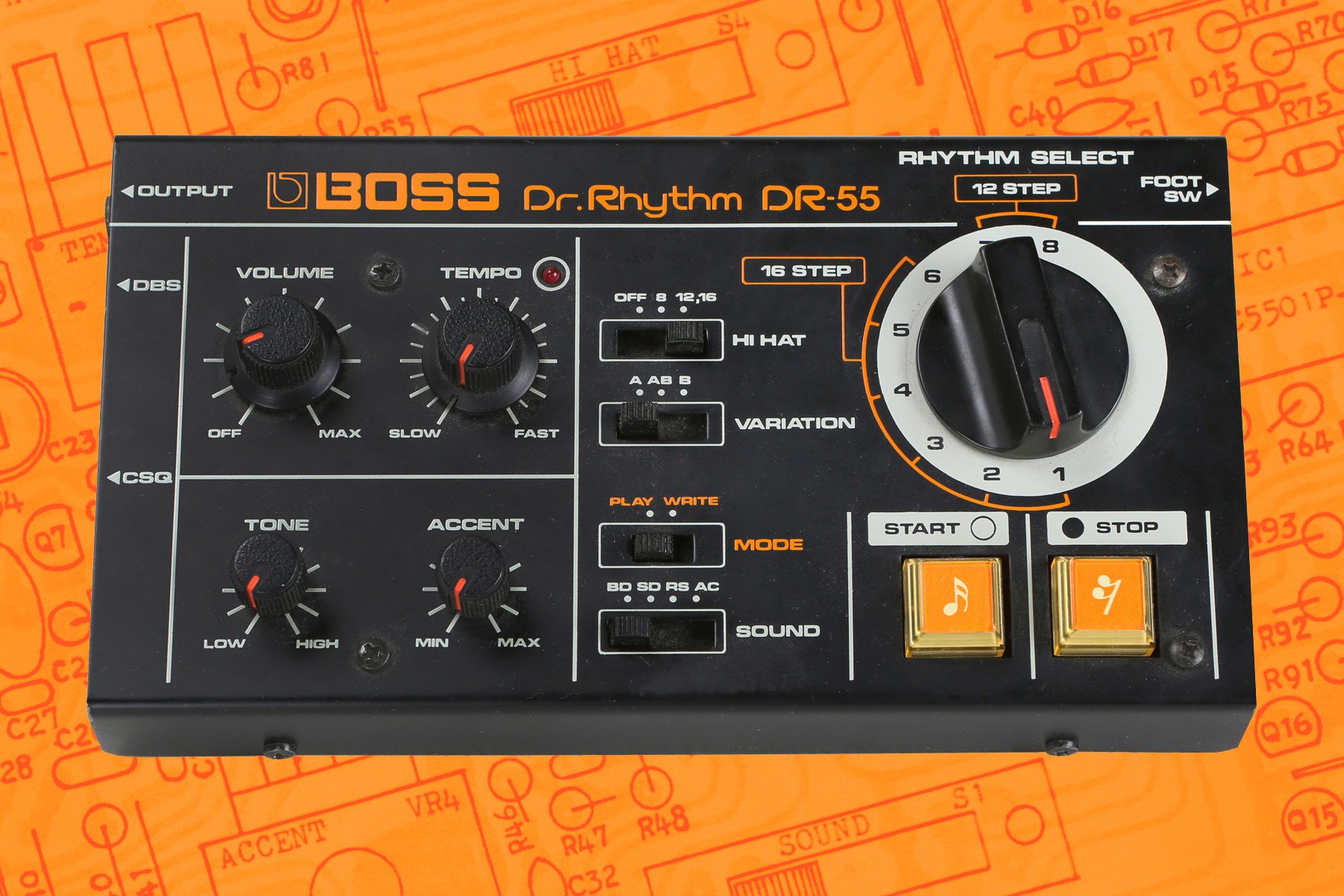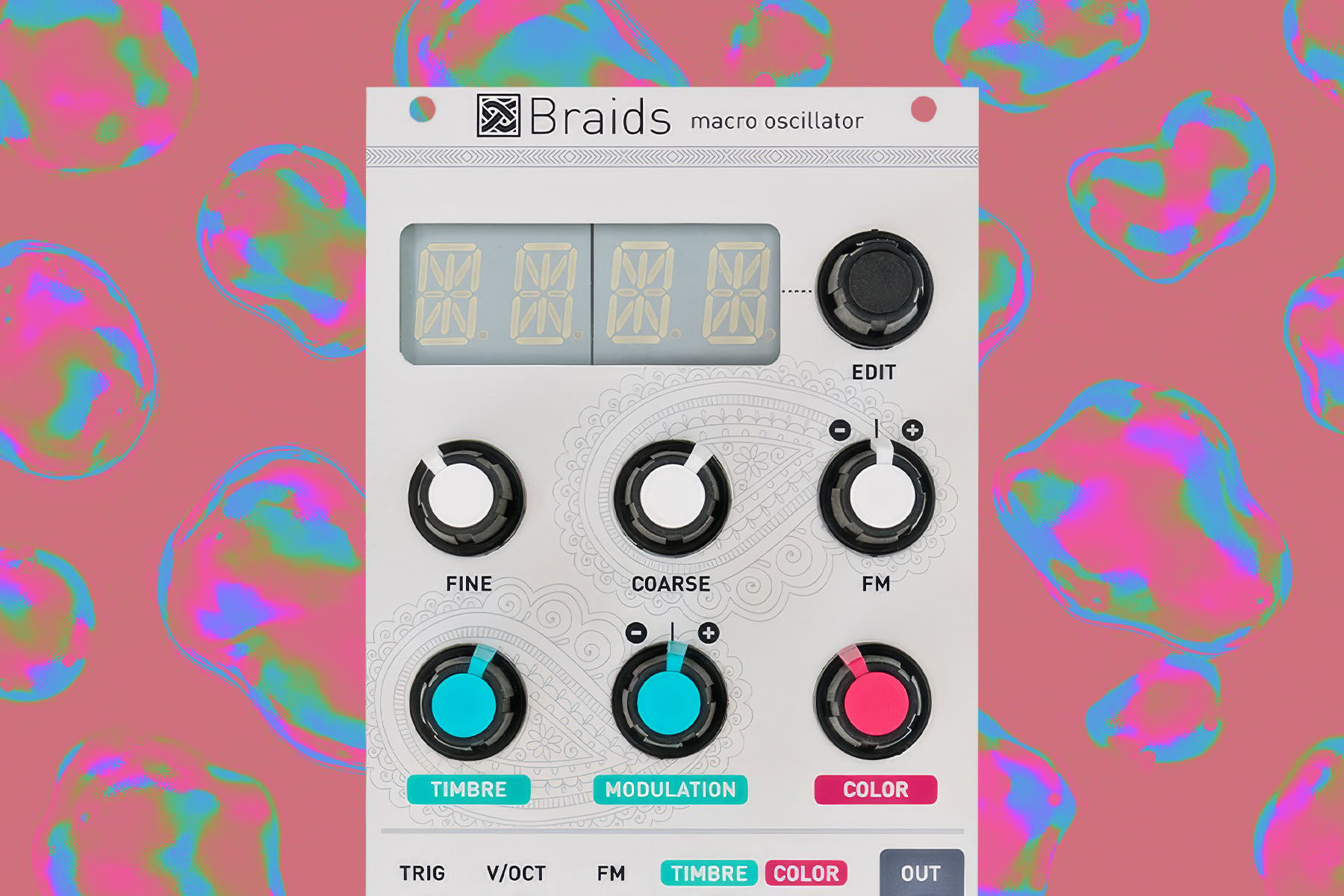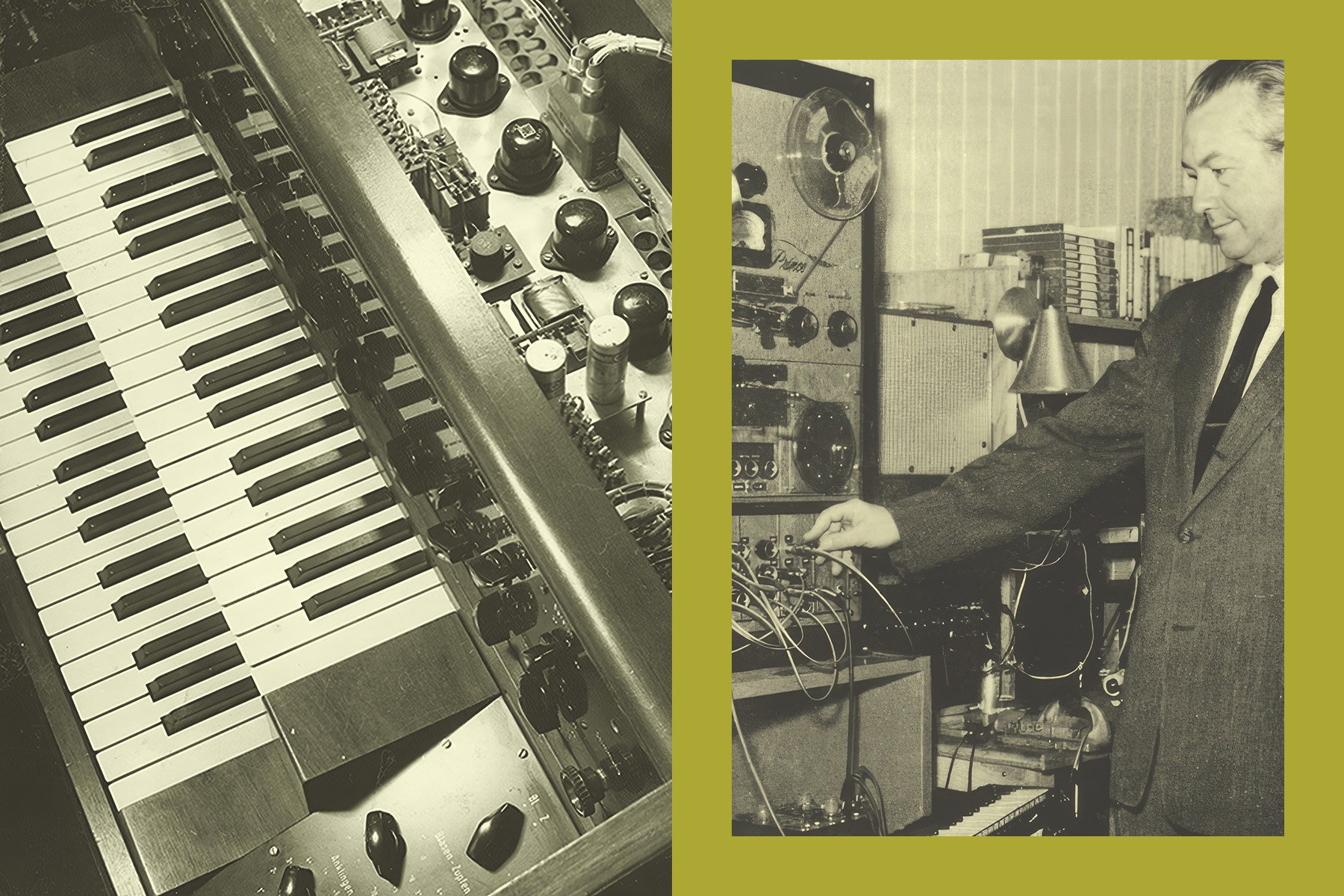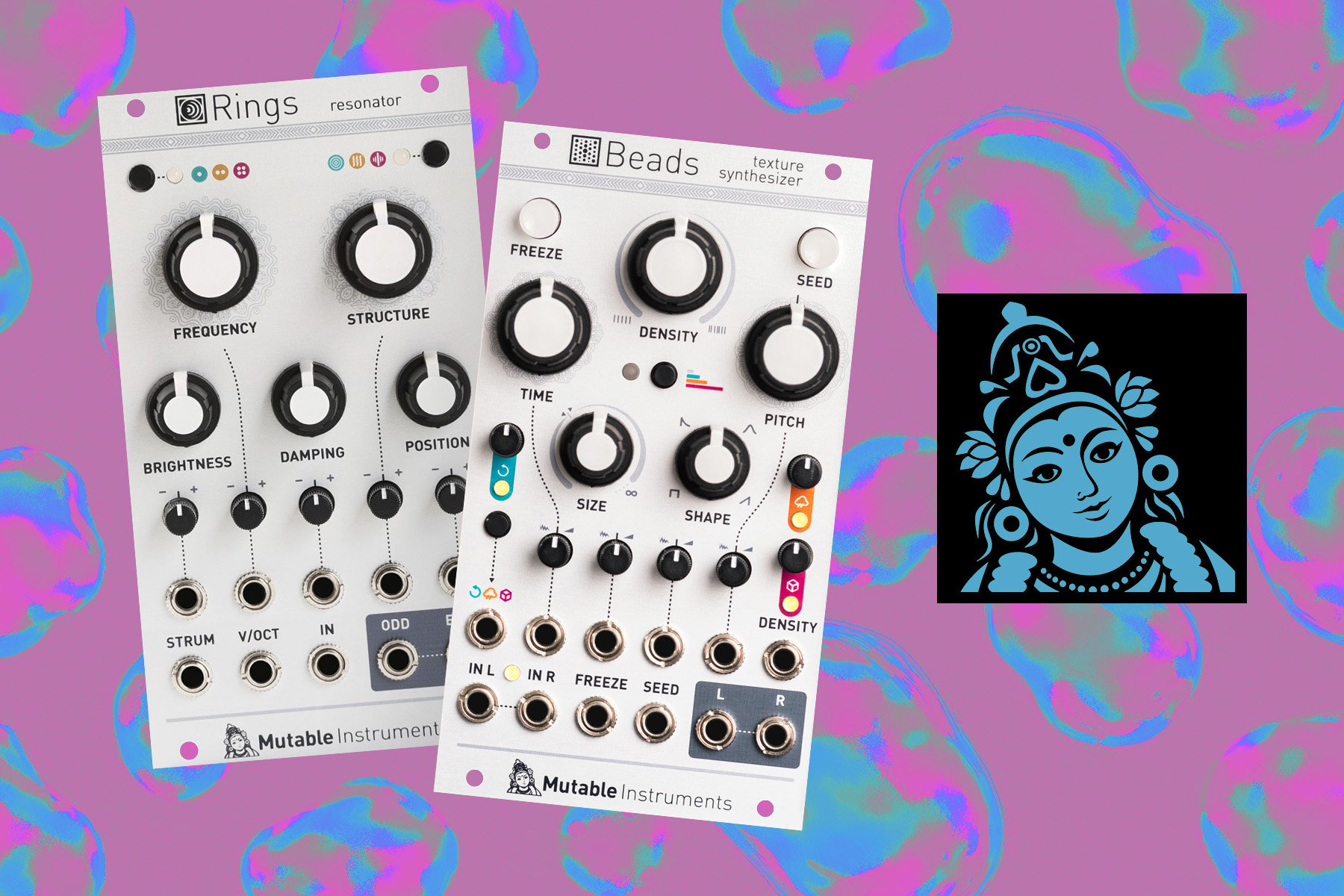Miles Davis loved fast cars. His collection eventually included a Mercedes-Benz 190 SL, several Ferraris, and the pièce de résistance—a custom lime green Lamborghini Miura, worth over $1.7 million today. Although this car sadly met an untimely demise on the West Side Highway in 1972, Davis collaborator Paul Buckmaster recalls that Davis kept a cassette tape of Karlheinz Stockhausen’s Hymnen in the car. It’s a fascinating image, instantly iconic—Davis steeped in the dense clangor and staccato electronic outbursts of Stockhausen’s tape mashup, settled amid the Miura’s flowing lines and low-slung silhouette, weaving through traffic beneath the George Washington Bridge.
Stockhausen might seem like an unlikely place for the jazz trumpet virtuoso, at the height of his career, to turn for inspiration. Born in 1928, Stockhausen emerged in the post-war period as an iconoclastic avant-garde composer in the German modernist tradition, renowned for blending rigorous serial-music techniques with groundbreaking electronic experimentation, creating works that explored profound spiritual and cosmic themes while reimagining the structure and experience of music itself. His theatricality shines in works of breathtaking scale such as Licht, a seven-opera cycle involving mystical characters such as Michael, Lucifer, and Eve, while latent mysticism is exemplified in works such as Gesang der Jünglinge, a groundbreaking work of musique concrète setting texts from The Book of Daniel, and Inori, a meditative work where a solo performer enacts ritualistic, prayer-like gestures from a platform suspended above an orchestra. Often regarded as the “father of electronic music,” Stockhausen was fascinated by the potential of electronic music to create sounds never before heard on earth. In the aftermath of World War II, a spirit of reconstruction and experimentation gripped West Germany, and the pioneering WDR Studio for Electronic Music in Cologne became a hub for reimagining what music could be. Stockhausen, working in this climate of innovation, repurposed test equipment like sine-wave generators, ring modulators, and oscillators—tools originally designed for scientific and industrial applications—into instruments that could craft entirely new sonic worlds. This approach reflected both the scarcity of traditional resources in post-war Germany and the burgeoning belief that technology could be harnessed for creative and transformative purposes, allowing Stockhausen to build bridges even with the popular music world. Famously, he appears on the cover of The Beatles album Sgt. Pepper's Lonely Hearts Club Band.
For Davis, whose career was marked by constant self-reinvention, Stockhausen’s radical approach to sound was a natural outgrowth of a musical reevaluation that was already well underway. Often misunderstood or overlooked by critics, Davis’s electric period, which is usually considered to begin with the 1967 recording of the track “Circle in the Round,” marked a dramatic departure from his earlier work, embracing a fusion of jazz with rock, funk, and experimental elements. This period saw Davis moving away from traditional structures and acoustic instruments, exploring instead new stylistic influences, the textural possibilities of amplified instruments, electronic effects, and studio techniques such as splicing and layering.
Stockhausen’s influence on Davis was not direct in a stylistic sense, but certain techniques—such as the use of process composition, intuitive performance, and the integration of found sounds—were mirrored in Davis’s own experiments. The influence was not unidirectional either. The two men met only once—at Columbia Studios in 1980, where they collaborated on a recording session that sadly still remains unreleased—but certain aspects of Davis’s influence are detectable in Stockhausen’s later works as well. Barry Bergstein, for example, has pointed out the particular importance of the amplified and processed trumpet in Stockhausen’s music, notably in pieces like Sirius (1975–77) and Donnerstag aus Licht (1978), where Stockhausen’s son Markus played trumpet using wah-wah effects and electronic processing techniques reminiscent of Davis’s electric period.
This reciprocal influence underscores the shared experimental ethos between the two artists. Stockhausen’s interest in transforming traditional instruments through electronic means aligns with Davis’s subversive use of amplification and effects pedals, which redefined the expressive potential of the trumpet. Moreover, Davis’s use of circular structures and non-linear editing in albums like Bitches Brew and On the Corner resonates with certain concepts that Stockhausen and others in the Darmstädter Ferienkurse circle were experimenting with in the 1970s.
The Electric Period
For those not steeped in the mid-20th-century jazz tradition, it can be hard to understand how controversial Miles Davis’s turn towards electric instruments was in the late 1960s and 70s. Herbie Hancock recalls thinking disdainfully that Davis wanted him to play a “toy” piano when he arrived at the studio to find a Fender Rhodes keyboard in place of a grand piano. Similarly, Keith Jarrett, who played with Davis’s band briefly from 1968 until the early 1970s, initially avoided Davis out of discomfort with electric keyboards, until swayed by a desire to work with the iconic bandleader. But while Jarrett distanced himself from electric keyboards after his stint with Davis—despite contributing memorable performances on instruments like the Fender Contempo Organ on Live-Evil (1971)—Davis fully embraced the electric and electronic, pushing further into uncharted territory and redefining jazz production techniques throughout the rest of his career.
Incorporating electric instruments had practical as well as aesthetic advantages. Keyboards were more portable than grand pianos and took up less space in small Manhattan recording studios. However, the primary motivation for Davis was to reflect the influences he was drawing from beyond traditional jazz. By the late 1960s, Davis had begun to immerse himself in the sounds of rock, funk, and global music traditions. Artists like Sly Stone, James Brown, and Jimi Hendrix were reshaping popular music with electric instruments and extended grooves, and Davis saw potential in these innovations for his own evolving musical vision. He was particularly inspired by the rhythmic complexity of funk and the expressive possibilities of amplified sound, which aligned with his desire to move away from the small-combo bebop format that had defined much of his earlier work. Electric instruments also allowed Davis to incorporate cross-cultural influences that had long intrigued him. Drawing on African and Indian rhythmic traditions, Davis began to layer these elements with the textures of electric keyboards and guitars.
Guitarist Reggie Lucas recalls that, for Davis, constant change and experimentation were not just musical practices but reflections of a broader philosophical approach to life—one that invited listeners to “think and reevaluate their fundamental beliefs about what life is and how it should be lived, what music is and how it should be created.” Contrasting Davis with artists who prefer “terra firma” and are “threatened by change,” Lucas recalls that “[Davis’s] goal was to create individuality and innovative expression at any time that he could. He was most contemptuous of artistic complacency and mediocrity.
These new sounds met with some initial mixed success, with the 1969 album In a Silent Way peaking at 134 on the US Billboard Top LPs charts and Bitches Brew (1970) eventually peaking at 35 on the US Billboard 200 and winning a Grammy Award in 1971. Oddly, rock critics were often more enthusiastic about the new style; jazz critics didn’t know how to classify the albums or thought Davis had abandoned jazz altogether for funk or rock. In retrospect, the early electronic albums sound rather tame in comparison to Davis’s later work. Besides the then-novel inclusion of electric guitars, it’s hard to understand the consternation they caused at the time.
In the 1970s, as Miles Davis continued to incorporate more and more electronic instruments and techniques into his work, many contemporaneous fans and critics turned on Davis. Ironically, given its esoteric experimental influences, many viewed his move towards electric instruments and the fusion of jazz with rock and funk as a commercial compromise or even a betrayal of jazz's acoustic roots. Traditionalists vilified the repetition and groove-driven structures of albums like On the Corner (1972), accusing Davis of pandering to popular tastes. The album was panned by NME critic Ian MacDonald as "monumentally boring" and saxophonist Stan Getz called the album “worthless” and wrote that the music “means nothing; there is no form, no content, and it barely swings.” But what critics failed to understand was that this shift was not about abandoning tradition but about redefining it. Davis saw music as a constantly evolving conversation, one that needed to reflect the energy and complexity of its cultural moment.
In recent years, Miles Davis’s legacy has seen a radical reevaluation, with Fact magazine and Pitchfork ranking On the Corner as among the greatest albums of the 1970s. Musicologists and critics now credit Miles Davis with laying the foundations for not only jazz fusion but also drum 'n' bass, trip hop, jungle, ambient, and even prog rock. Davis’s influence on the classical music experimental tradition is less studied but no less significant. From Stockhausen to Brian Eno and minimalism, it’s certain that the art music scene in the late 20th century was listening and was deeply impacted by Davis’s explorations of texture, rhythm, and sonic layering as well.
Early Experiments: In A Silent Way and Bitches Brew
One of the first masterpieces of his electric period, Miles Davis’s 1969 album In a Silent Way has been called “one of the blueprints for ambient music” and “a proto-ambient masterpiece." Scored for trumpet, saxophone, electric guitar, three electric keyboards, acoustic bass, and drums, the sound was like nothing the jazz world had heard before. Characterized by its subtle textures, extended grooves, and flowing, almost hypnotic melodies that float above ostinati, In a Silent Way wasn’t like the dense electronic tapestries Davis would create in later years either.
In a Silent Way plays with jazz conventions. While the primary texture throughout is created by the three Fender Rhodes Electric Pianos played by Chick Corea, Herbie Hancock, and Joe Zawinul and subtle electric guitar riffs by John McLaughlin, there’s more tradition here than at first meets the ear. Davis’s solo after the tempo change in the title track is derived from the blues and Barry Bergstein has pointed out how the tremulous melodic material floating above repetitive elements, often featuring Wayne Shorter on sax, can be seen as a reworking of the collective improvisation technique used in traditional New Orleans-style jazz.
One element of In a Silent Way that was perhaps truly unprecedented in jazz history was how Miles Davis assembled the album. With the help of legendary jazz producer Teo Macero, Davis assembled In a Silent Way in the studio using a cut-and-splice technique. Macero recalls that Davis would take four-hour recording sessions and cut them down to just eight minutes of material, the magnetic tape of which Macero would then cut and splice manually, looping these elements to create disembodied washes of texture and sound.
These experiments preceded Miles Davis’s exposure to Karlheinz Stockhausen’s Telemusik (1966), a composition in which Stockhausen similarly employed splicing and layering techniques, incorporating ethnographic field recordings and other sonic materials. Scottish jazz musician Ian Carr recalls visiting Davis in 1972 and hearing him play Telemusik over and over at high volume through his custom home sound system, a testament to Davis’s fascination with the work. Davis’s experiments with tape loops also slightly predate or are roughly contemporaneous with Brian Eno and Robert Fripp’s experiments with tape loops and tape-delay feedback, which gained notoriety with their collaborative album (No Pussyfooting) in 1973.
Recorded just six months after In a Silent Way, Davis’s 1970 album Bitches Brew was already radically more ambitious and subversive, a sprawling double album that redefined the possibilities of jazz and established Davis as a pioneer of the fusion movement. The album was scored for a massive ensemble that brought back John McLaughlin on electric guitar, Wayne Shorter on soprano saxophone, and Joe Zawinul and Chick Corea on electric keyboards, and added an electric bass, bass clarinet, and up to three percussionists at a time. Bitches Brew exploded the conventions of jazz, embracing extended forms, dense polyrhythms, and the power of amplified and electronically altered instruments to create music that was as much about texture as it was about melody or harmony.
Bitches Brew is particularly notable for Miles Davis and Teo Macero’s heavy use of electronic effects, many of which were added in post production. This included an echo effect custom built for Macero called the “Teo One Tape Delay” as well as noise gates, which were used as a special effect to give an alien sound to certain passages. As with In a Silent Way, Bitches Brew was constructed from samples in the studio, with the second half being constructed entirely from clips taken from hours of studio improvisations, spliced together to form layered, non-linear musical narratives. The results are immersive—an atmospheric soundscape where instruments seemed to dissolve into one another, blending into a swirling collective voice. (These experiments with splicing reached yet another milestone on the album Big Fun, with the track in question recorded in March 1970. In a famous passage [starting at 11'47''] in “Go Ahead John,” Macero spliced clips of Davis together with other clips of himself, creating an illusory duet—Miles Davis soloing with himself.)
Both In a Silent Way and Bitches Brew are particularly notable in that they finally broke with the longstanding tradition that jazz recordings represent an authentic record of a studio session, or at least one of many possible versions of a session. Although material from the sessions was later released as The Complete In a Silent Way Sessions and The Complete Bitches Brew Sessions, these records are no more their eponymous compositions than would be the raw footage of a film be considered the film itself. An idea later popularized by Brian Eno—who imagined the recording studio as an instrument in itself—author Philip Freeman notes that:
“[Davis and Macero] created a permanent schism between records and live appearances. Certain effects and sounds were simply impossible to replicate onstage, like the switching from side to side of John McLaughlin's guitar and Billy Cobham's drums on ‘Go Ahead John,’ or the shift from a rock-oriented quintet to an ocean of electric piano on ‘Yesternow.’”
Yet, as so often in Davis’s career, innovations born in the studio eventually shaped the band's live performances. By the early 1970s, recordings reveal the musicians increasingly mimicking the rapid textural shifts of Macero’s edits, even in their live shows.
On The Corner
Few jazz albums have divided opinion as sharply as On the Corner. To its critics, it was a betrayal—an unrecognizable descent into repetitive grooves and electrified chaos that abandoned jazz's sophistication for a funk-inspired grab at mass appeal. But for its fans, On the Corner isn’t just revolutionary; it was a middle finger to jazz purists clinging to the past. Miles Davis didn’t just break the rules—he obliterated them, laying the groundwork for hip-hop, ambient, and electronic music. What sounded like schlock to some was heard as a manifesto for the future by others.
On The Corner is steeped in two seemingly contradictory impulses: Davis admired and sought to capture the energy of popular artists like Sly and the Family Stone and James Brown as well as influences from Indian and African music; simultaneously, Davis was, in 1972, also deeply engrossed in the music and experimental techniques of Karlheinz Stockhausen. He was particularly stricken by Stockhausen’s idea of “polyvalent process composition,” a method that provides a framework of symbols and rules that performers interpret to create unique versions of a piece through gradual accretion of erosion, rather than by following a fixed score. In Stockhausen’s score for Plus-Minus (1963), for instance, performers manipulate musical events—such as adding, removing, or transforming sounds—based on specified processes, leading to vastly different outcomes while adhering to the structure of the original instructions. In his autobiography, Miles Davis reflects on Stockhausen's influence:
“Through Stockhausen I understood music as a process of elimination and addition. Like ‘yes’ only means something after you have said ‘no.’ I was experimenting a lot, for example, telling the band to play rhythm and hold it and not react to what was going on; let me do the reacting.”
On The Corner marked a new chapter in Miles Davis’s exploration of electronic effects as well. In his autobiography, Davis recalls that he first explored the wah-wah pedal (a variable band-pass filter controlled by a rocking foot pedal, which modulates the frequency peak of the signal to produce its characteristic “wah” effect) as a way to try to make his trumpet sound more like an electric guitar. It was also convenient that the wah-wah, commonly associated with rock guitarists like Jimi Hendrix, offered Davis an electronic imitation of his signature Harmon mute—a distinctive, acoustic filter that brass players typically manipulate with one hand. By introducing the wah-wah pedal into his electric repertoire, Davis found a way to retain the intimate, vocal-like quality of his muted trumpet but at higher volume in the context of an electric ensemble.
However, the wah-wah soon became much more than an effect for Davis. In the early 1970s he used it more and more often and encouraged his band to use it as well. In On the Corner the frequent and simultaneous use of the wah-wah pedal by different members of the ensemble is used to an extreme, often inducing a jarring and even chaotic element into the timbre. Davis plays through the wah-wah apparently throughout the entire record, although Teo Macero has said this was added during post-production.
Musically, On The Corner is defined more by rhythmic improvisation than by melody. Whereas previous albums such as In a Silent Way and Bitches Brew still try to maintain an illusion of an “honest” session recording, the technical artifice is the point in On The Corner. As Phil Freeman puts it:
“There is no postmodern wink here. Instead, [On The Corner seems] intent on immersing the listener in a totally absorbing world of sound.”
Throughout On The Corner the “lead” voices were mixed deliberately low so that they appear to be heard only through an unremitting lattice of groove laid down by Jack DeJohnette, Billy Hart, and Al Foster on drums. Recorded on a 16-track recorder with most instruments plugged directly into the soundboard, the instruments sound unerringly crisp, almost like samples. This recording method gave Davis and Macero unprecedented control in post production which allowed them to create auditory illusions that would be impossible in a live acoustic environment. Instruments enter and leave the mix unexpectedly, and the hand drums and claps of Don Alias and James Mtume and the Indian tabla drums played by Badal Roy appear much lowder and at the front of the mix in comparison to the rest of the ensemble:
“When On the Corner is heard through speakers, it's like listening from Mtume's or Alias' vantage. The congas and percussion are quite often the loudest things, with the rest of the band filling in around them.” [Freeman]
There’s an aspect to On The Corner which is deliberately brash, a side to the work also emphasized by the colorful cartoon cover art by Corky McCoy, which contrasts markedly from other Miles Davis album covers which tend to emphasize Miles Davis himself, often in sybaritic closeup. The starkness of the rhythmic groove and overtly synthetic approach to orchestration, treating the ensemble almost like a sampler, foreshadowed heavier dance style, drum 'n' bass, even early minimalism and EDM.
On The Corner was misunderstood at the time of its release. Not knowing how else to classify the album, Columbia Records simply released it like any other jazz record. The jazz audience promptly rejected it, and since it was positioned as a jazz record, the rock, funk, and experimental audiences, who might have embraced its originality, never heard it. Lacking the shrewd advertising campaign and zeitgeist that had buoyed Bitches Brew, On The Corner was a commercial flop. Only in recent decades has the album become a cult favorite, part of a wider reevaluation of Miles Davis’s legacy during his electric period. What was once dismissed as indulgent or incomprehensible has now been embraced as visionary. On the Corner is now widely recognized as a bold artistic statement—and as a premonition of many trends that would come to define the 1970s.
Tutu
On The Corner—along with two live recordings, Agharta and Pangaea, both recorded February 1975—marked the end of Miles Davis’s early 70s style. Following the crash of the Lamborghini Miura in 1972 and a series of personal crises, Davis took an almost ten year sabbatical. Although Davis produced a few records in the early 80s, it wasn’t until 1986 that he returned to the studio to record an album on the scale of his work from a decade prior, and when he did, it was in a completely new and much more resolutely electronic style.
Planned as a collaboration with Prince, the album, which was named in tribute to Archbishop Desmond Tutu, was heavily influenced by 80s R&B and funk. The new sound was indicative of Davis’s changing artistic interests but also made possible in part by the technical evaluation of electronic instruments in the decade prior. Central to the album's sound was the synthesizer programming of Jason Miles, a synthesizer virtuoso and studio musician whose synthesis expertise would eventually be heard on albums by artists such Aretha Franklin, Whitney Houston, and Michael Jackson. As Jason Miles told Sound On Sound in 1999, “Creating depth is a matter of layering the right sounds together. But you have to know your synthesizers, and be willing to discover how they work.”
This ethos is evident in Tutu's rich, textured soundscapes, achieved through instruments like the PPG Wave 2.3 and Emu Emulator ll, which allowed for a blend of sharp digital tones and lush analog warmth (as well as some pretty experimental sampling). Miles’s approach to programming these instruments was meticulous, rejecting presets and quick fixes in favor of sounds tailored specifically to fit Davis’s vision. "Organic," he said, "does not necessarily mean a natural sound. Organic could mean a very electric or synthetic sound, but if it’s right for the song and the arrangement, it will sound organic."
Davis’s insistence on unique, carefully crafted sounds resonated deeply with Jason Miles. “Miles Davis always told me that creating your own sound is the most important thing in music,” Jason noted. “I believe that it’s one of the reasons why he was so attracted to what I was doing, because my synth stuff sounded different to anybody else’s.”
Tutu’s rhythmic foundation, built around the Linn 9000 drum machine, was equally groundbreaking, offering tightly controlled beats that punctuated Davis’s soaring trumpet lines. Paired with the lush textures of the Oberheim Matrix 12, Yamaha DX7/TX 416, and Sequential Prophet V, the result was a sound that push the boundaries of what electronic instruments could achieve in a jazz context, elevating Tutu beyond the sterile, preset-heavy production of many 80s records. As Jason Miles observed, this kind of synthesis required a deep commitment to exploring the technology: “There was a time when synth manufacturers started taking buttons off their machines, and it became much more complex to program a synth. But today that excuse has become bullshit, because more and more synths have lots of knobs on them. So it is very possible to find sounds that will give your music character, and that’s what people should be doing.”
While Tutu was a qualified success, and is often credited with reinvigorating Davis’s career in the 1980s, the electronic sounds on the album have been controversial in the decades since, as they were at the time of its release. Robert Palmer wrote contemporaneously in the New York Times that the album "already sounds curiously dated." This was a criticism leveled at many early electronic artists pushing the envelope into the “uncanny valley” of digital synthesis in the 1980s. Wendy Carlos’s Digital Moonscapes (1984), laboriously composed on the cutting edge Crumar General Development System (GDS), was the target of similar opprobrium. Yet the combination of the detailed synth programming and the hard-swinging melodic improvisation that Davis brought to Tutu ultimately helped establish the album as a landmark of jazz combined with electronic music. Over time, Tutu has remained relevant not merely as a product of its era but as a forward-looking work that redefined the possibilities of jazz fusion, paving the way for future explorations of the genre.
Conclusion
Davis’s willingness to experiment with everything from tape splicing to digital instruments reflects a broader legacy: the embrace of the unknown and the courage to innovate even within a venerated musical tradition, while at the same time embracing and responding to certain aspects of that tradition. This ethos resonates strongly with the emergence of ambient, minimalist, and electronic music movements in the late 20th century. Artists like Brian Eno and Terry Riley, who were deeply inspired by Davis’s electric period, similarly sought to reimagine the role of texture, repetition, and sound manipulation in their compositions.
Bibliography + Further Reading
- Bergstein, Barry. “Miles Davis and Karlheinz Stockhausen: A Reciprocal Relationship.” The Musical Quarterly, vol. 76, no. 4, 1992, pp. 502–25. JSTOR, http://www.jstor.org/stable/742474. Accessed 28 Dec. 2024.
- Davis, Miles, and Quincy Troupe. Miles, the Autobiography. Simon and Schuster, 1989.
- Freeman, Phil. Running the Voodoo Down : The Electric Music of Miles Davis. Backbeat Books, 2005.
- Miles, J. (2019, August 13). The making of Miles Davis Tutu. Headphone Guru. http://headphone.guru.dream.website/the-making-of-miles-davis-tutu/
- Shekailo, Darren E., "Electronics and the Music of Miles Davis" (2018). CUNY Academic Works. https://academicworks.cuny.edu/hc_sas_etds/351
- Tingen, P. (1999, October). JASON MILES: Miles Ahead. Sound On Sound. https://www.soundonsound.com/people/jason-miles-miles-ahead

